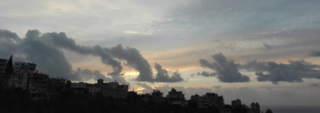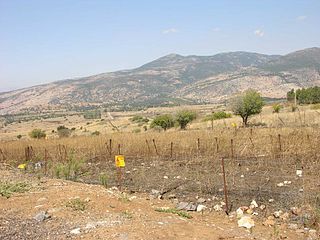
Choueifat is one of the biggest and most important cities in southeast of Beirut in Lebanon. The city is a Druze enclave that lies on the eastern side of Beirut's airport. The local population of the city is made up of mostly Druze and Christians minority, but in the last 25 years, many Beirutis have moved in to escape the capital's high rents, while many southerners have found Choueifat a good alternative to the crowded southern suburb known as Dahieh.
This is a list of aviation-related events from 2006.
This is a timeline of events related to the 2006 Lebanon War.

The 2006 Qana airstrike was an airstrike carried out by the Israeli Air Force (IAF) on a three-story building in the small community of al-Khuraybah near the South Lebanese village of Qana on July 30, 2006, during the 2006 Lebanon War. The strike killed 28 civilians, 16 of whom were children. Israel halted airstrikes for 48 hours following the attack, amid increasing calls for a ceasefire in the conflict between Israel and Lebanon's Hezbollah guerrillas.
There were many casualties in the 2006 Lebanon War, leading to condemnation of both sides, however the exact distribution of casualties has been disputed. The Lebanese Higher Relief Council (HRC), UNICEF, and various press agencies and news organizations have stated that most of those killed were Lebanese civilians, however the Lebanese government does not differentiate between civilians and combatants in death toll figures. The Israeli government identified 43 Israeli civilians killed by Hezbollah rocket attacks, including four who died of heart attacks during rocket attacks. The Israel Defense Forces (IDF) death toll ranges from 118 to 121, depending on the source and whether or not casualties that occurred after the ceasefire are included. The figures for the Hezbollah fighters killed are the most varying, with Hezbollah claiming 250 of its fighters killed, while Israel claimed to have identified 530 dead Hezbollah fighters. The IDF estimates 600–700 dead Hezbollah fighters. Sources can be conflicting.
The 2006 Al-Qaa airstrike was an attack by the Israel Air Force (IAF) on a building in the area of al-Qaa around 10 kilometers from Hermel in the Bekaa Valley, Lebanon on 4 August 2006. The attack took place during the 2006 Lebanon War. Thirty-three farm workers, mostly Syrian and Lebanese Kurds, were killed during the airstrike.
The 2006 Ghaziyeh airstrikes also referred to as the 2006 Ghaziyeh massacre were two sequential attacks by the Israel Air Force (IAF) on the city of Ghaziyeh in Lebanon on August 7, and August 8, 2006. The attacks took place during the 2006 Lebanon War. In the first attack on August 7, the IAF bombed a building killing 16 people. In the second attack on August 8, the IAF fired five missiles into three buildings killing a total of 8 to 14 civilians and wounding 33. A total of 26 to 30 civilians died in the attacks.
The 2006 Marjayoun convoy was a convoy of approximately 759 vehicles containing Lebanese police, army, civilians, and one Associated Press journalist, which was attacked by the Israeli Air Force (IAF) as it travelled away from the area of Marjayoun on August 11, 2006. Marjayoun is a predominantly Christian town about 8 km (5.0 mi) from the border with Israel.
This is a timeline of the 2006 Lebanon War during early August.
The 2006 Lebanon War photographs controversies refers to instances of photojournalism from the 2006 Lebanon War that misrepresented scenes of death and destruction in Lebanon caused by Israeli air attacks.

The 2000–2006 Shebaa Farms conflict was a low-level border conflict between Israel and Hezbollah for control of Shebaa Farms, a disputed territory located on the Golan Heights–Lebanon border. Fighting between the two sides primarily consisted of Hezbollah rocket and mortar attacks on Israel and Israeli artillery barrages and airstrikes on Hezbollah in southern Lebanon. Clashes began a few months after the 2000 Israeli withdrawal from Lebanon, which Hezbollah viewed as incomplete due to the presence of the Israel Defense Forces in Shebaa Farms. The conflict culminated in the 2006 Lebanon War; Israel retains control over the territory.
During the 2006 Lebanon War, Amnesty International, Human Rights Watch, and United Nations officials accused both Hezbollah and Israel of violating international humanitarian law. These have included allegations of intentional attacks on civilian populations or infrastructure, disproportionate or indiscriminate attacks, the use of human shields, and the use of prohibited weapons.

The 1979 Nahariya attack was a raid by four Palestine Liberation Front (PLF) militants in Nahariya, Israel on 22 April 1979.
The Iran–Israel conflict during the Syrian civil war refers to the Iranian–Israeli standoff in and around Syria during the Syrian conflict. With increasing Iranian involvement in Syria from 2011 onwards, the conflict shifted from a proxy war into a direct confrontation by early 2018.
This timeline of the Israel–Hezbollah conflict covers the period from 1 April 2024, when Israel struck the Iranian consulate in Damascus, to 26 July 2024, one day before the Majdal Shams attack.
This timeline of the Israel–Hezbollah conflict covers the period from 27 July 2024, when a Hezbollah rocket struck a soccer field in Majdal Shams in the Golan Heights, killing 12 children, to 16 September 2024, one day before the explosion of Hezbollah pagers and walkie talkies.
This timeline of the Israel–Hezbollah conflict covers the period that begins 17 September 2024, when Hezbollah pagers exploded throughout Lebanon and Syria, and ends prior to 27 November 2024, when the 2024 Israel–Lebanon ceasefire agreement was signed. Beginning 23 September, Israel began its airstrikes in Lebanon, on 27 September, they assassinated Hassan Nasrallah, and on 1 October, they invaded Lebanon.




